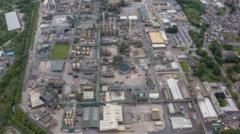Will 300 Job Cuts at the Chemical Factory Impact the Industry?

Understanding the Impact of Job Losses in the Chemical Industry: A Case Study of Dow's Factory Closure in Barry, Wales
The recent announcement by Dow, a prominent player in the chemical industry, about the closure of part of its factory in Barry, Wales, has sent ripples through the local community and the broader industrial landscape. With 291 jobs set to be lost as operations scale down, the implications extend beyond those directly affected to impact the entire region's economy. This article delves into the reasons behind Dow's decision, the broader context of job losses in the chemical industry, and the potential consequences for the workforce and local economy.
The Closure of Dow's Barry Factory: A Historical Perspective
The Barry factory, located in the Vale of Glamorgan, has been a cornerstone of chemical production since the 1940s. Over the decades, it has played a significant role in the manufacturing of siloxanes, essential chemical compounds that form the basis of many everyday products, including sealants and adhesives. The factory's long-standing presence marks it as a vital contributor to both local employment and the global chemical supply chain.
What Are Siloxanes?
Siloxanes are versatile compounds composed of silicon and oxygen. They are integral to various applications, ranging from personal care products to industrial applications. Their unique properties, such as temperature resistance and flexibility, make them indispensable in the formulation of:
- Sealants
- Adhesives
- Cosmetic products
- Silicone rubber
The Reasons Behind Dow's Decision
In a statement regarding the closure, Dow cited "structural challenges in the region" as the primary reason for the factory's downsizing. This phrase encapsulates a range of factors, including:
- Market Dynamics: The chemical industry in Europe is grappling with fluctuating demand and increasing operational costs. These pressures can make it challenging for companies to maintain profitability.
- Global Competition: With many chemical manufacturers around the world, competition has intensified, leading to a need for companies like Dow to streamline operations and cut costs.
- Technological Advancements: Innovations in manufacturing processes may reduce the need for labor in certain areas, contributing to job losses.
The Broader Economic Landscape
Dow's decision is not an isolated incident but rather a reflection of trends within the global chemical sector. In January 2023, the company announced cuts amounting to £736 million, resulting in a workforce reduction of approximately 1,500 roles worldwide. This highlights a concerning pattern where large companies are forced to make tough decisions to remain competitive amidst economic uncertainty.
The Immediate Consequences for Employees and the Community
The impact of the factory's closure on the local workforce is profound. Approximately 850 employees currently work at the Barry site, and the loss of nearly a third of these jobs will undoubtedly lead to significant economic strain on affected families. The Unite union has voiced strong opposition to the layoffs, labeling the move as "outrageous" and emphasizing the "devastating" impact on staff morale and community stability.
Potential Effects on the Local Economy
The closure will likely have a ripple effect on the local economy, including:
- Increased Unemployment: The direct loss of jobs will contribute to higher unemployment rates in the area, leading to increased reliance on social services.
- Reduced Local Spending: As former employees tighten their budgets, local businesses may experience a decline in sales, affecting their sustainability.
- Property Values: An increase in unemployment and a decline in disposable income can lead to decreased property values, affecting homeowners in the region.
Future Outlook: What Lies Ahead for Dow and the Chemical Industry?
The shutdown of the Barry factory is expected to commence in mid-2026, with full decommissioning and potential demolition extending into 2029. This protracted timeline suggests that the impact will be felt for years to come, both by employees and the community. The closure also raises questions about the future of the chemical industry in Europe, particularly in light of ongoing challenges.
Will Other Sites Face Similar Cuts?
In addition to the Barry factory, Dow is also expected to implement cuts at two of its European sites in Germany, bringing the total job losses across the three locations to around 800. This raises concerns about whether other factories may follow suit, further destabilizing the industry.
Potential for Job Retraining and Transition
While the immediate outlook appears grim for those affected by the job losses, there may be opportunities for retraining and transition. Initiatives that focus on reskilling workers for emerging industries could help mitigate the long-term impact of these layoffs. The chemical industry is evolving, and as new technologies develop, there may be demand for skilled workers in different areas.
Conclusion: Navigating Change in the Chemical Sector
The news of Dow's factory closure in Barry serves as a stark reminder of the challenges facing the chemical industry and the broader implications for local communities. As companies navigate structural changes and market dynamics, the consequences for employees and the economy can be profound. While the loss of jobs is an immediate concern, the potential for retraining and adaptation may offer a glimmer of hope for those affected.
As we move forward, it is essential for stakeholders—including government agencies, educational institutions, and businesses—to collaborate and develop strategies that support displaced workers and ensure a resilient economic future.
FAQs about Dow's Factory Closure and the Chemical Industry
What is the timeline for the factory closure in Barry?
The shutdown is expected to begin in mid-2026 and be completed by the end of 2027, with potential decommissioning continuing into 2029.
How many jobs are being lost due to the factory closure?
A total of 291 jobs will be lost at the Barry factory, with additional cuts at two other European sites bringing the total to approximately 800 job losses.
What are siloxanes, and why are they important?
Siloxanes are chemical compounds made of silicon and oxygen, serving as essential ingredients in many products, including sealants, adhesives, and cosmetics.
What support is available for workers affected by the job losses?
While specific support measures will vary, potential resources may include retraining programs and job placement services offered by local government and community organizations.
How does this closure reflect trends in the chemical industry?
This closure is part of a larger trend of job losses within the chemical sector, as companies face challenging market dynamics and a need to streamline operations to remain competitive.
The challenges facing the chemical industry are significant, but so too are the opportunities for transformation and growth. As we navigate these changes, how can we best support the workers and communities affected by industrial shifts? #ChemicalIndustry #JobLoss #EconomicImpact
Published: 2025-07-08 11:12:06 | Category: wales



